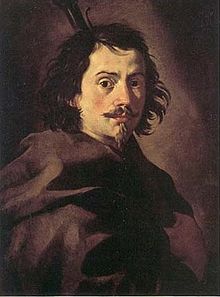Francesco Borromini | |
|---|---|
 Borromini (anonymous youth portrait) | |
| Born | Francesco Castelli 25 September 1599 |
| Died | 2 August 1667 (aged 67) |
| Occupation | Architect |
| Buildings | San Carlo alle Quattro Fontane, Sant'Agnese in Agone, Sant'Ivo alla Sapienza, Oratorio dei Filippini |
Francesco Borromini (/ˌbɒrəˈmiːni/,[1] Italian: [franˈtʃesko borroˈmiːni]), byname of Francesco Castelli (Italian: [kaˈstɛlli]; 25 September 1599 – 2 August 1667),[2] was an Italian architect born in the modern Swiss canton of Ticino[3] who, with his contemporaries Gian Lorenzo Bernini and Pietro da Cortona, was a leading figure in the emergence of Roman Baroque architecture.[4][5]
A keen student of the architecture of Michelangelo and the ruins of Antiquity, Borromini developed an inventive and distinctive, if somewhat idiosyncratic, architecture employing manipulations of Classical architectural forms, geometrical rationales in his plans and symbolic meanings in his buildings. He seems to have had a sound understanding of structures, which perhaps Bernini and Cortona, who were principally trained in other areas of the visual arts, lacked. His soft lead drawings are particularly distinctive. He appears to have been a self-taught scholar, amassing a large library by the end of his life.
His career was constrained by his personality. Unlike Bernini who easily adopted the mantle of the charming courtier in his pursuit of important commissions, Borromini was both melancholic and quick in temper which resulted in his withdrawing from certain jobs.[6] His conflicted character led him to a death by suicide in 1667.
Probably because his work was idiosyncratic, his subsequent influence was not widespread but is apparent in the Piedmontese works of Guarino Guarini and, as a fusion with the architectural modes of Bernini and Cortona, in the late Baroque architecture of Northern Europe.[7] Later critics of the Baroque, such as Francesco Milizia and the English architect Sir John Soane, were particularly critical of Borromini's work. From the late nineteenth century onwards, interest has revived in the works of Borromini and his architecture has become appreciated for its inventiveness.
- ^ "Borromini, Francesco". Lexico UK English Dictionary. Oxford University Press. Archived from the original on 2020-06-09.
- ^ Peter Stein. "Borromini, Francesco." Grove Art Online. Oxford Art Online. Oxford University Press. Web. 25 Jul. 2013. <http://www.oxfordartonline.com/subscriber/article/grove/art/T010190>
- ^ "Francesco Borromini." Encyclopædia Britannica. Web. 30 Oct. 2010.
- ^ "Symposia Melitensia" (PDF). University of Malta Junior College. September 2017. ISSN 1812-7509.
- ^ Wieland, Martin; Gorraiz, Juan (28 May 2020). "The rivalry between Bernini and Borromini from a scientometric perspective". Scientometrics. 125 (2): 1643–1663. doi:10.1007/s11192-020-03514-5. ISSN 1588-2861. S2CID 214747325.
- ^ Blunt, Anthony (1979), Borromini, Harvard University Press, Belknap, p. 21
- ^ Blunt,(1979), p. 213-7